Last Updated on February 10, 2023 by Matt
Blennies are a popular aquarium fish. They are useful for controlling algal growth, and also have unique behaviors and characteristics. Many blennies have quite muted colors, but the Clown Blennies of the Ecsenius genus definitely don’t. They are very colorful fish, displaying a wide range of bright colorations.
In this article and guide to the Ecsenius Clown Blennies, we will first explain their classification and how they are related to other blennies, describe their habitat, range, and natural history, their diet, and the compatibility in aquariums and what tank mates are suitable. We will finish with a species list and pictures of the members of this amazing genera.
IN THIS ARTICLE
Classification
The term “Blenny” is used for a broad range of marine and freshwater species of fish sharing similar physical characteristics.
There are six families which are considered to be true blennies; the Blenniidae, which are the combtooth blennies, the Chaenopsidae, which has the pikeblennies, tubeblennies and flagblennies, the Clinidae, which emcompasses the clinids including the giant kelpfish, the Dactyloscopidae, also known as the sand stargazers, the Labrisomidae, and the Tripterygiidae, the threefin blennies.
All of these six families are closely related and are grouped together in the order Blenniiformes.
In this article we will be focussing on the clown blennies, the common name for members of the genus Ecsenius in the family Blenniidae. The Blennidae family is the most diverse of the blenny families, with 401 species in 58 generas. Collectively they are known as the Combtooth Blennies, characterized by their blunt heads and jaws filled with comb-like teeth.
The Blenniidae family is split into two subfamilies, the Salarinae and the Blenniinae. Members of the Ecsenius clown blennies are members of the Salarinae subfamily. They are the largest genus of blenny in the whole Blenniidae family with 53 species.
Habitat and Natural History
Habitat
Individual species in the Ecsenius genus have quite limited ranges themselves, however members of Ecsenius are found throughout the Indo-Pacific region. They are tied to coral reefs, being found almost exclusively on coral reefs amongst stony corals such as acan coral. The majority of species are found on fringing coastal reefs, reef flats, and atolls where the coral reef ecosystem is less than 50 meters deep.
The limited range of the individual species is probably due to a couple of factors; the fact that they are tied intimately to coral reef ecosystems, and that they have a very short larval stage. A short larval stage limits the opportunity for a species to disperse, as the larvae have only a short period to find a coral reef to inhabit. This also means that original and satellite populations of the same species are much less likely to intermingle and exchange genetic information. Therefore over time the original and satellite populations change genetically and become separate, though closely related, species. This could explain why the Ecsenius genus is the most diverse of the Blennidae family.
Natural History
Clown Blennies lack a swim bladder. Therefore they cannot remain suspended in the water column; they are negatively buoyant and sink to the substrate. When they dart out of their hiding places and off the coral into the water column they need to continuously move their pectoral fins in order to hold themselves in place.
As such, they spend the majority of their time on the substrate. This is normally the hard rock that they call home, and are never far from their hiding place, usually a hole. When startled they will enter their hole with their head sticking out so they can scout the area. They will emerge when they deem the coast is clear.
Clown Blennies usually live a solitary life, and have a small territory which they will defend. Multiple conspecifics (members of the same species) are often seen on the same coral or patch of reef. While territorial battles are rare in the natural environment, in the aquarium where space is limited they can be more frequent.
Territorial battles are normally ritualized, with no actual fighting. The blennies will give threat displays, and the first blenny to back down loses. However if neither does then they will bite the head and neck area with their teeth, lock jaws, and chase each other. Unless space is at an absolute premium serious injuries are unlikely.
While most Clown Blennies retreat into a hiding place to avoid predation and seek shelter, some species of Ecsenius have different tactics. For instance the Midas Blenny (E. midas) engages in social mimicry, and the Red Sea Mimic Blenny (E. gravieri) displays Batesian mimicry.
The Midas Blenny mimics the coloration of Anthias and can be seen swimming and hiding with the schools they form. This decreases the predation risk as there are more fish for the hunter to choose from. The Red Sea Mimic Blenny mimics the coloration of the Blackline Fang Blenny (Meiacanthus nigrolineatus). This blenny is venomous, and when it is eaten by a predator it uses its venomous teeth to bite the cheek of the predator. As you can imagine, the predator quickly spits out the Blackline Fang Blenny. Predatory fish have quickly learnt to leave this blenny alone, so by mimicking its coloration, the Red Sea Mimic Blenny is protected as well.
Species of the Ecsenius genus lay demersal eggs in a sheltered location, usually a hole in the rock or a shell. In some species the eggs are attached to the wall of the hiding place with thin filaments. The eggs are small, measuring about 0.75 mm long and 0.5 mm wide. When they are ready to hatch the male will fan them, oxygenating the eggs and preparing the larvae.
While it isn’t definite, it is highly likely that Clown Blennies are protogynous hermaphrodites. This means that they are born female, and change to male as they age and mature. Males are usually larger than females, which is typical of protogynous hermaphrodites. There is more dimorphism displayed by Clown Blennies which lends its hand to them being protogynous hermaphrodites, which is that males have filaments extending from the caudal fin, and extra rays on the dorsal fin.
Diet
The diet of the majority of Clown Blennies consists of algae and detritus that they get from scraping and rasping the hard rock substrate they call home.
However as usual there are some Clown Blennies that have differences as well. The Bicolor Blenny and the Red Sea Mimic Blenny also have coral polyps on the menu. They eat algae as well, but coral polyps make an important part of their diet.
Some Ecsenius species also eat zooplankton. The Midas Blenny is often seen darting into the water column to catch zooplanktonic organisms.
Aquarium Compatibility and Tank Mates
Ecsenius Clown Blennies make great additions to any saltwater reef tank. They do require lots of hiding places, and need lots of stony corals in order to thrive. As such they aren’t suitable for fish only tanks.
In order to make Ecsenius species comfortable in your reef aquarium, you should ensure that there are plenty of holes, crevices, and nooks and crannies for them in which to hide. Ecsenius species like tight spaces, and you can use a drill to create appropriately sized holes in the live rock for them to hide in. They will also hide in shells, and the tubes created by serpulid worms.
The minimum aquarium size that Clown Blennies need depends on the individual species and the size that they can reach. However these are small fish, and are suitable for smaller tanks. For example the Tail Spot Blenny (Ecsenius stigmatura), is only 2.5 inches long and needs a minimum of a 10 gallon fish tank, while the Yellowtail Black Blenny (Ecsenius flavipes) reaches 4 inches and needs a 30 gallon tank minimum.
While the tank size Clown Blennies need varies, as they are very closely related and are all found on coral reefs in the Indo-Pacific region, they require the same water conditions. These are a temperature of 72-78°F, carbonate hardness of 8-12 dKH, a pH range of 8.1-8.4, and specific gravity of 1.020-1.025.
Care does need to be taken if you are going to have Clown Blennies in small tanks, such as 10 gallon and 20 gallon setups. As these species mainly feed on algae, there will be less food for them present in smaller tanks as compared to larger tank setups. Therefore their diet does need to be supplemented to ensure they remain healthy.
If there is little algal growth in the tank then they need to be fed three times or more a day. If there is a good supply of algae for them to graze on then once a day should suffice. Be aware that sometimes an aggressive feeding regime is required. You should feed them frozen foods or sinking foods that contain Spirulina, blue-green algae, such as Hikari Freeze Dried Cubes and Omega One Sinking Pellets
While Clown Blennies are in general very peaceful creatures, they can and will be aggressive towards other small benthic fish if they try to invade their territory. This is especially the case if hiding places are at a premium, which is why it is so important to provide Ecsenius species with many possible hiding spots.
Most likely though is that they are on the receiving end of unpleasant treatment. Benthic fish such as Hawkfish and larger Blenny species have been noted to be quite aggressive towards Clown Blennies. If you are thinking of housing species like this with your Clowns, then a larger tank than the minimum is highly recommended to give Ecsenius as much space as possible and as many hiding spaces as possible so they can get away from the larger species.
While the majority of species of the Ecsenius genus will leave corals alone, some do nip coral polyps. The Bicolor Blenny (E. bicolor) and the Red Sea Mimic Blenny (E. gravieri) have been known to nip at small polyp stony corals. Other species may eat slime from large polyp stony corals, though this is mainly due to a lack of algae to feed on in the tank.
Species List
This section is a full species list of the Ecsenius Clown Blennies, along with a description and a picture. Possibly the only full species list out there!
Ecsenius aequalis – Commonly known as the Fourline blenny, it is found in the western Pacific ocean on the northern portion of the Great Barrier Reef and Trobriand Islands of Papua New Guinea. They reach a length of 1.7 inches, and have a light white/pale grey coloration with clear transparent fins. The eyes have a yellow ring. Notably they have four dark lines running the length of the body, hence their common name.

Photo Credit: Rick Stuart-Smith / Lizard Island Field Guide http://lifg.australianmuseum.net.au/Hierarchy.html. License: CC BY Attribution
Ecsenius alleni – Commonly known as Allen’s blenny, it is found in the Eastern Indian Ocean, specifically Western Australian coral reefs. The upper body has a grey-brown coloration, and a white underside. There are black bars on the back, which change to brown on the side of the fish. At the pectoral fin base is a large white-edged black spot. There are white stripes through the eye.

Photo Credit: Rick Stuart-Smith
Ecsenius aroni – Commonly known as Aron’s blenny, it is found in the Red Sea and Gulf of Aqaba. They have transparent fins with a dark spot at the caudal fin base. They have a dark orange upper body and light lower body, with a dark grey/black head. A light orange/yellow bar runs along the top of the body at the base of the dorsal fin.
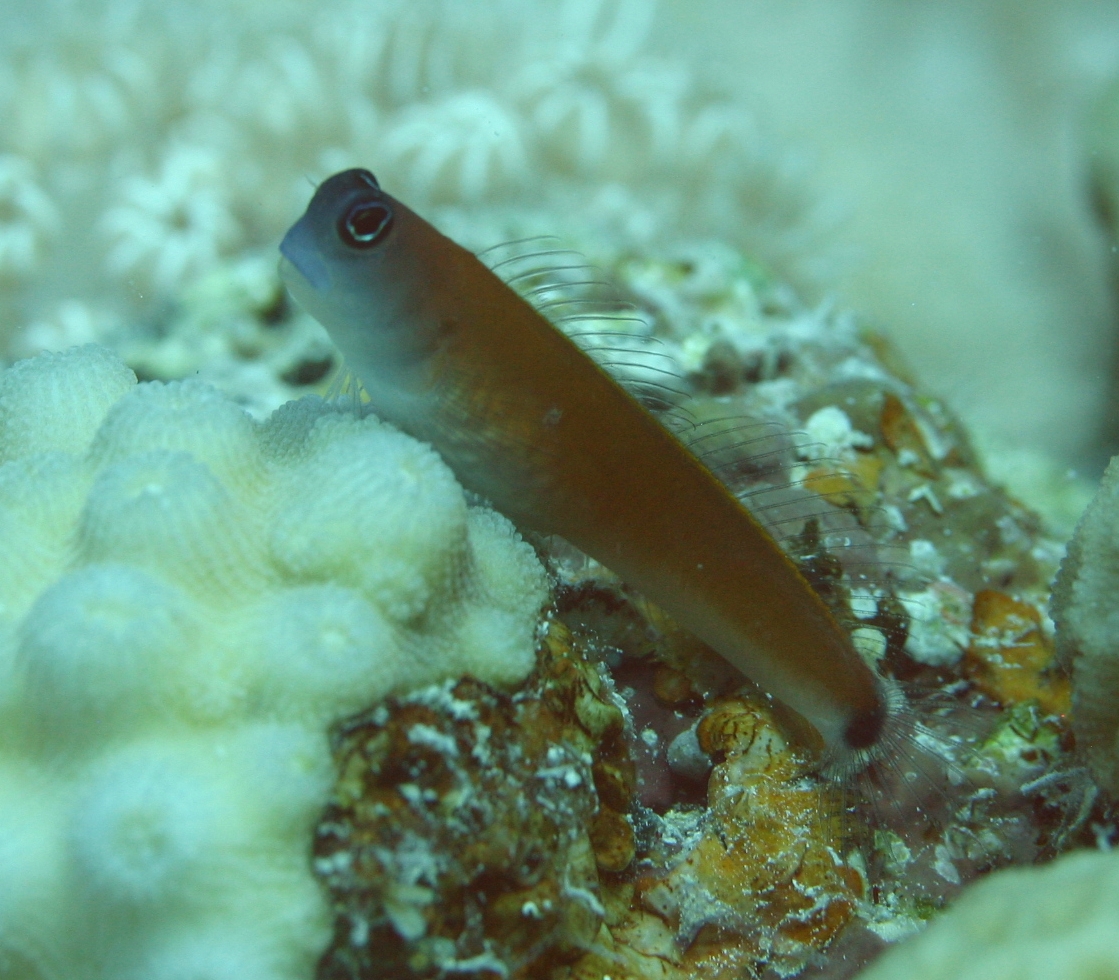
Photo Credit: Dave Cullen
Ecsenius australianus – Commonly known as Australian blenny, they are found on the Great Barrier Reef and Coral Sea of Australia. A small species, only 2.4 inches long, they have a mixed coloration. The ventral third is white, and the dorsal ⅔ is reddish brown. White spots form two rows, and a red/brown strip with white edges passes from the operculum through the eye.

Photo Credit: Nick Hobgood (WikiCommons)
Ecsenius axelrodi – Commonly known as Axelrod’s clown blenny, it is found in shallow water coral reefs of the western central Pacific Ocean. It has an orange body with white stripes running the length. It has transverse black bars on the rear half of the body, and four black spots before these bars under the dorsal fin. Notably it has a black spot at the pectoral fin base. The eyes are prominent with a black bar through.

Photo Credit: Jenny Huang (Flickr)
Ecsenius bandanus – Known as the Banda clown blenny, it is found in the Western Pacific Ocean. It has a light cream coloration, with a black bar running over the eyes to just past the operculum. Fins are transparent, and a greyish area is behind the pectoral fins.

Photo Credit: Andrew Green
Ecsenius bathi – The Bath’s comb-tooth is small, only 1.6 inches long. Found in the western central Pacific. It has a pale grey/white body with three prominent black bars running the length. It has an amazing pale yellow head, with bright yellow and black bars running over the eye.

Photo Credit: Nhobgood Nick Hobgood, CC BY-SA 3.0, https://commons.wikimedia.org/w/index.php?curid=5635006
Ecsenius bicolor – The Bicolor blenny is found in the Indo-Pacific region in Fiji, Indonesia, and Sri Lanka. As the name suggests, the body has twin coloration; the anterior half is a blue to brown color, while the posterior half is a muted orange. Large, reaching 4.3 in, and exhibit great personality in an aquarium.

Photo Credit: Ian Shaw
Ecsenius bimaculatus – Known as the Twinspot coral blenny, they are so called due to the two black spots on the stomach area of their cream colored bodies. A black band also runs through the eye onto the body. They are small, only 1½ inches long, and have large eyes with a small mouth, giving a rather interesting look. They are found in coral reefs surrounding the Philippines.

Photo Credit: Rickard Zerpe (Flickr)
Ecsenius caeruliventris – At 0.9 inches, the Bluebelly blenny is one of the smallest in the genus and found in Indonesia. It is a pale yellow color, with a yellow face and black and white striped eyes. It is named for the blue coloration of its stomach.
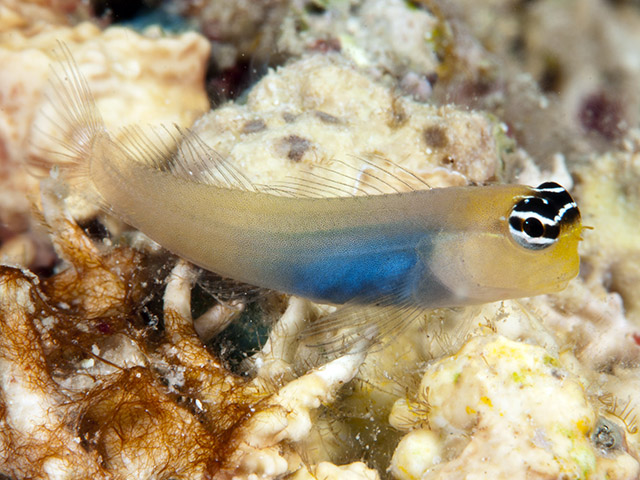
Photo Credit: Andrey Ryanskiy
Ecsenius collettei – Collete’s blenny reaches two inches in length and is found in Papua New Guinea. They have a pale cream body with three lines of black spots which extend the length of the body. They have a very pale brown head with yellow and black eyes.

Photo Credit: John E. Randall (Fishbase)
Ecsenius dentex – Reach 1.9 inches in length and is found in the Gulf of Aqaba and the northwestern Red Sea. They are a muted purple/dark brown color with faint grey spots in a hexagonal pattern along the length of the body. They have two dark lines on the ventral side running from the head past the pectoral fin, with more muted dark lines on the dorsal side. Have small orange spots on the cheek.

Photo Credit: Rick Stuart-Smith
Ecsenius dilemma – The Twocoat Coralblenny is small, reaching 1.2 inches and originates from the Philippines. Pale pink head, cream body with three sienna brown/orange lateral stripes running the length from the head. Transverse black bars the length of the body, the first two and the 6th don’t dissect the body completely.

Photo Credit: http://www.akkiira.com/isoginnpo/Ecsenius-dilemma.html
Ecsenius fijiensis – The Fiji Clown Coralblenny is endemic to the Fiji Islands, and reaches 1.5 inches. Has a pale head with black band on the top of the head. Top of the head can be dark or yellow. Body is a pale pink/cream/yellow coloration with two lateral faint dark bars on the anterior of the body, with the posterior half having seven pairs of prominent black spots.

Photo Credit: John Randall
Ecsenius fourmanoiri – The Blackstriped combtooth blenny reaches 1.9 inches in length and is found in the western Pacific. Body and head have a pale pink base coloration. A dark brown stripe runs at the dorsal fin base, while two more run from the head along the body. Bands between the stripes form a grid. Distinctive brown chinstrap, and line through eye continues as middle body line.

Photo Credit: Rick Stuart-Smith
Ecsenius frontalis – The Smooth-fin blenny is found in several gulfs in the Red Sea, and reaches 3.1 inches. Has a couple of color morphs, dark blue, pale grey, and pale blue with dark band on lateral line with yellow head. Fins have characteristic smooth rounded appearance. Two antennae-like cirri situation before the eyes.
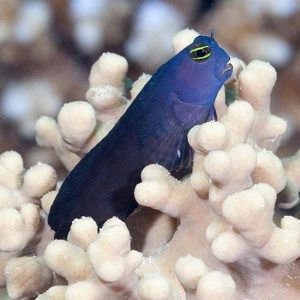
Ecsenius gravieri – The Red Sea mimic blenny is endemic to the Red Sea, reaching 3 inches. The coloration is designed to mimic that of Meiacanthus nigrolineatus, which has venomous fangs it uses to bite the cheeks of predators that try to ingest it. Would-be predators quickly spit it out and learn to stay away. Have a yellow/green/blue coloration with black markings that follow the lateral line, below the dorsal fin.

Photo Credit: Alain Feulvarch (Flickr)
Ecsenius isos – Found around New Hebrides and New Caledonia, this blenny reaches 1.3 inches. Pale cream coloration with a slightly pinkish head. ‘Isos’ references the dark spots around the head. Has three lateral lines of dark spots.
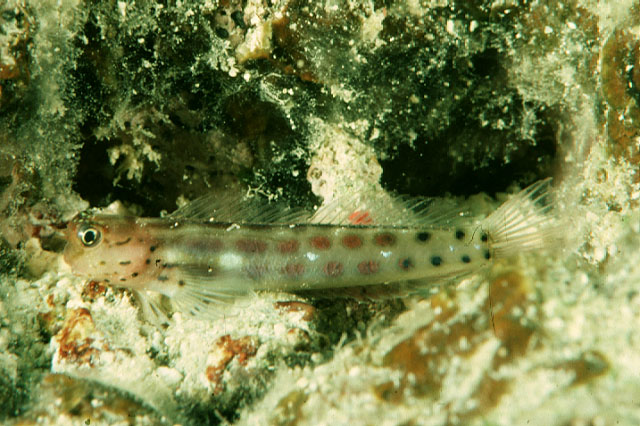
Photo Credit: John Randall https://www.fishbase.se/collaborators/CollaboratorSummary.php?id=50
Ecsenius kurti – Kurt’s coralblenny is endemic to the Cuyo Islands of the Philippines. Reaches 1.4 inches. Pinkish head with pale sienna body. Three thin dark brown lateral lines running the length of the body. Lines become spots at posterior. Eyes are dark with a yellow ring and spots.
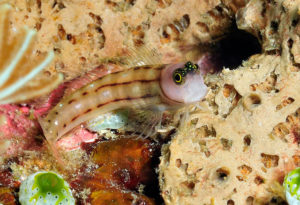
Photo Credit: Andrey Ryanskiy https://www.fishbase.de/collaborators/CollaboratorSummary.php?id=2292
Ecsenius lineatus – The Linear blenny reaches 3.1 inches and is found from Eastern Africa to the Philippines. Ventral half of the body is white, and dorsal half is dark brown/black. White line at base of dorsal fin. Thin pale lines between white lower half and white line.

Photo Credit: http://www.akkiira.com/isoginnpo/hitosujiginnpo.html
Ecsenius lividanalis – Blue-head combtooth-blenny has two color forms, both of which have a black spot around the anus. One morph has a yellow body and iris with blue head. The other morph has a dark, occasionally all yellow body with a bluish-white iris, and yellow back and caudal fin.

Photo Credit: John Randall https://www.fishbase.se/collaborators/CollaboratorSummary.php?id=50
Ecsenius lubbocki – Lubbock’s combtooth-blenny reach 1.6 inches and are found in Thailand. Has a pair of black spots on the back of the head and a dark chinstrap. Dark lateral bands.

Photo Credit: Seasav http://www.inaturalist.org/photos/3470610
Ecsenius mandibularis – Queensland blenny reach 3 inches and are found off the Queensland coast on the Great Barrier Reef. Pale grey with two lines of bright white spots running the length of the body.

Photo Credit: John Randall https://www.fishbase.se/collaborators/CollaboratorSummary.php?id=50
Ecsenius melarchus – Yellow-eyed comb-tooth blenny reach 2 inches and are found in the western Pacific. A dark grey/cream body with dark pale blue head. Distinct yellow ring on the eye, and black mark around the anus. The name melarchus is latin for black anus and references this marking.

Photo Credit: MachielvdZ, CC BY-SA 4.0, https://commons.wikimedia.org/w/index.php?curid=81597877
Ecsenius midas – The Persian blenny is widespread in the Indo-Pacific region, and is large at 5.1 inches long. Usually a golden orange but can adapt the coloration to mimic the fish species it hides amongst.

Photo Credit: Jason Marks, CC BY-SA 3.0, https://commons.wikimedia.org/w/index.php?curid=18286187
Ecsenius minutus – The Collar blenny is endemic to the Maldives, and reaches 1.6 inches. The posterior end of the body is pale brown with light spots, while the anterior body is light with dark blotches, and the noticeable dark collar extending from the jaw to lateral line. They have a yellowish head.

Photo Credit: Víctor Cebollada, CC BY-SA 4.0, https://commons.wikimedia.org/w/index.php?curid=31305174
Ecsenius monoculus – Found in the reefs around Indonesia and the Philippines. Reaches 2 inches in length and has a dark body with a lighter head and light spots along the body. Has a dark chin strap, and white and black spots at the base of the caudal fin.

Photo Credit: John Randall https://www.fishbase.se/collaborators/CollaboratorSummary.php?id=50
Ecsenius nalolo – Nalolo blennies reach 2.5 inches and are found in the western Indian Ocean. Their body has a pale pink base coloration with white spots along the length. Two yellow lines on the head behind the eye, often accompanied by dark bands as well.
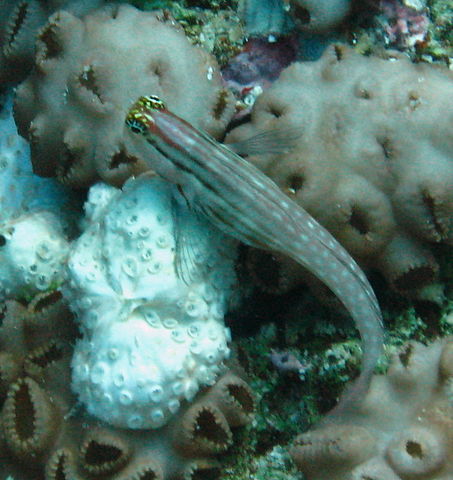
Photo Credit: Matthieu Sontag (User:Mirgolth) CC BY-SA 3.0, https://commons.wikimedia.org/w/index.php?curid=12049133
Ecsenius namiyei – Black comb-tooth blenny is widespread in the western Pacific Ocean and reaches 4.3 inches in length. They have a dark blue coloration with a bright yellow patch at the base of the caudal fin.

Photo Credit: Izuzuki, CC BY-SA 2.5, https://commons.wikimedia.org/w/index.php?curid=32260561
Ecsenius niue – Reaches 1.2 inches and is endemic to Niue Island, as referenced to in the scientific name. Only discovered in 2002, it is very similar to the Fijian endemic E. fijiensis. The only difference is it has six rather than seven pairs of dark spots on the posterior body.

Photo Credit: Niue blenny, Ecsenius niue Springer, 2002, collected 4 October 1998, Beveridge Reef, SW lagoon, Niue. CC BY 4.0. Te Papa (P.035765)
Ecsenius oculatus – Known as the Ocular Coralblenny, it reaches 1.9 inches and is found on Christmas Island and North Western Australia. Has a sienna-brown body with white-edged black spots on dorsal side of the body, with white spots on the ventral side. Anterior body has white lines and spots. Has a brown chinstrap line.

Photo Credit: Rick Stuart-Smith
Ecsenius oculus – Known as the Ocular blenny, it hails from Ryukyu Islands, southern Taiwan, the Philippines and Papua New Guinea. It reaches 2.8 inches and is very similar to E. oculatus. The difference is that the white-edged black spots on the body come in pairs and has a dark line behind the eye.

Ecsenius ops – The Yellow Eye Combtooth Blenny has a distinctive yellow ring around its eye, and has cryptic coloration to help with camouflage. It is counter shaded through the lateral line; the dorsal half is sienna brown/dark yellow while the ventral half is a much lighter tone. Head can be blue. Reaches 3 inches, and is found in Indonesia.

Photo Credit: Jim Greenfield
Ecsenius opsifrontalis – Known as the Comical blenny and Latticed Blenny, it has a black lattice-like patterning over gradients of red, white, and pink. They reach 2 inches in length, and are found in the Pacific Ocean. Lies to dig through substrate.

Photo Credit: John Randell
Ecsenius pardus – Found around Fiji it reaches 1.9 inches. Dark brown body with black spots ringed by white found in a diagonal pattern along the body. Pair of cirrus found on the rim of the anterior nostril.

Photo Credit: Randall, J.E., https://www.fishbase.in/References/FBRefSummary.cfm?ID=28618
Ecsenius paroculus – Known as the Spottedback coralblenny, it is found in the Indonesia and reaches a length of 1.6 inches. It is so called for the line of dark spots that run the dorsal side of the brown body. Dorsal fin has a deep notch, and has cirrus on the nostril.

Photo Credit: Richard Winterbottom
Ecsenius pictus – Known as the Pictus blenny, or the white lined comb tooth, it is found in Indonesia, Papua New Guinea, Solomon Islands, and the Philippines. It reaches 2 inches long and ‘pictus’ means painted in latin referring to its coloration. It has a black body with white lines and spots running laterally. The posterior has a yellow coloration with transverse dark bands. One white line runs to the eye; below this line the head is white, above is dark yellow.

Ecsenius polystictus – The Dotted coralblenny is found in Indonesia and reaches 1.6 inches long. It has a pale body with small dark spots. Has a dark chinstrap line, and a dark patch at the pectoral fin base.
Ecsenius portenoyi – This blenny is found in the western central Pacific Ocean, notably around Fiji and Samoa, and reaches 1.8 inches long. Has a pinkish head, and a light sienna body. A black and white line starts at the eye and extends down the body. The black line finishes past the operculum but the white extends to the caudal fin. Has a dark chin strap line and dark spots both on dorsal and ventral sides of the body.

Photo Credit: John Randall https://www.fishbase.se/collaborators/CollaboratorSummary.php?id=50
Ecsenius prooculis – Found in the reefs surrounding Papua New Guinea and the Solomon Islands. Reaches 1.5 inches, and has a white head with pale grey body. Has three thick dark lateral lines, the middle of which extends to the eye.

Photo Credit: John Randall https://www.fishbase.se/collaborators/CollaboratorSummary.php?id=50
Ecsenius pulcher – Known as the Gulf blenny, it is found in gulfs in the western Indian Ocean such as the Persian Gulf, Gulf of Oman, and Gulf of Kutch. There are different color morphs; the most striking has a dark blue head and anterior body. The posterior body is yellow with transverse black bars. Another morph is all dark blue. Another has spilt coloration laterally. The dorsal side being dark, and the ventral side being white.

Photo Credit: Parviz Tavakoli Kolour (WikiCommons)
Ecsenius randalli – A very small species found around Indonesia, reaching 0.8 inches long. Pale brown body with a yellow-edged dark brown stripe which connects the eyes and continues down the body to a dark spot at the pectoral fin base. Has 2 small spots above this line, with around 9 pairs of dark spots down the body. One spot is ventral, and one dorsal. Pairs of spots can be joined in a transverse line. Caudal fin is notched, and cirrus present on the nostril.

Photo Credit: Randall, J.E., 1997
Randall’s underwater photos.
Ecsenius schroederi – Known as Schroeder’s coralblenny, it is found in Indonesia and reaches 2.8 inches long. Has thin dark lines down its pale brown body. Has two mid-lateral dark lines close together with a series of white spots between them. Also has line of small white spots beneath the dorsal fin.
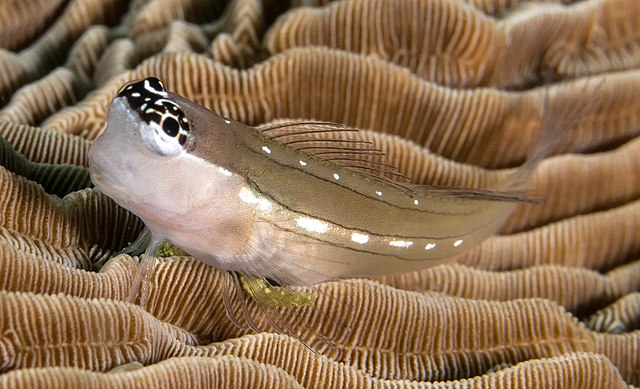
Photo Credit: Rickard Zerpe (Flickr)
Ecsenius sellifer – Known as the Saddle blenny, it is found in the Western Pacific in areas like Papua New Guinea and the Solomon Islands. It reaches 1.6 inches long, and is named after the large black patches on its back, like a saddle. Dark mottled head and body base coloration. Three large dark patches on the posterior body are fringed with white. White lines and spots run from the operculum to the tail.

Photo Credit: John E. Randall
Ecsenius shirleyae – Shirley’s blenny is found in Indonesia and reaches 1.1 inches long. It is very similar in coloration to E. bimaculatus, only lacking the twin spots. It has a cream/grey coloration to the body, a silver stomach, and a black line connecting the eyes, then running through the eye and to the operculum. Underneath this line the head is white, above is dark grey.

Photo Credit: Randall, J.E., 1997
Randall’s underwater photos.
Ecsenius stictus – The Great Barrier Reef blenny is found on its namesake reef and the Chesterfield Islands. It reaches 2.3 inches long. It has a coppery orange coloration making it camouflage incredibly well with corals.

Photo Credit: Graham Edgar (WikiCommons)
Ecsenius stigmatura – Known as the Tail Spot Blenny, they reach 2½ inches in length and are found in the Western Pacific. Can have different color morphs, but in general have a muted copper colored body, and the defining characteristic is a dark spot followed by a white bar at the tail base. A black and yellow line runs under the eye which can change to bright pink when threatened.

Ecsenius taeniatus – The White-lined coralblenny reaches a length of 1.3 inches and is found in Papua New Guinea. It has a dark body, and light yellow colored head. There are three white lines, one under the dorsal fin, one in the middle, and one low on the body running from the operculum the length of the body. The middle line extends to the eye. Pair of cirrus found in front of the eyes.

Photo Credit: John E. Randall
Ecsenius tessera – Reaches a length of 1.8 inches and is found on the reefs around Vanuatu. Dorsal fin is very notched, and coloration of the body is head and anterior body is dark. The posterior half of the body is covered in large tile-like dark spots on which are surrounded by pale, grout-like interconnected lines. Fins can have a reddish tinge.

Photo Credit: Randall, J.E., 1997 Randall’s tank photos.
Ecsenius tigris – The Tiger blenny reaches 2 inches long and is found in the western Coral Sea. Tan coloured body with a row of black spots or short bars along the back under the dorsal fin. There are white spots between the bars, and a midlateral row of white dashes, with a second row of short black bars along the ventral portion.

Photo Credit: Randall, J.E., 1997 Randall’s tank photos.
Ecsenius tricolor – The Derawan combtooth-blenny is found in Indonesia, the Philippines, and Borneo. The head is a deep blue color, which continues to the body and gradually changes in a gradient to bright orange at the tail. It has a very distinctive bright blue/white line below the eye that normally continues to at least the midpoint of the body. Has a bright orange line under this on the operculum.

Ecsenius trilineatus – Known as the Three-lined blenny, it is found in the western Pacific Ocean and reaches 1.2 inches long. Pale body and head with three thin dark lines and bright white spots which make it distinctive. Eye is ringed with yellow and has yellow spots in the top side.
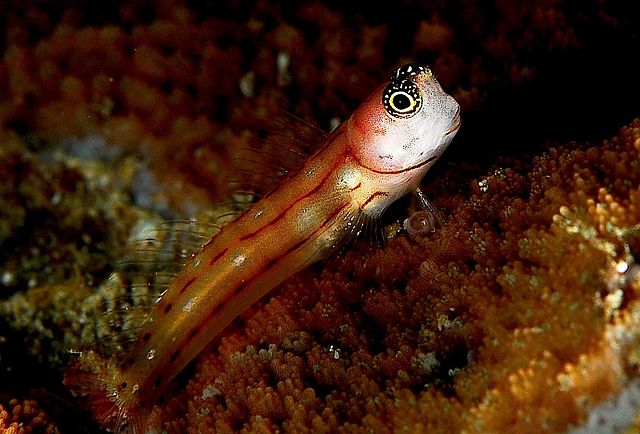
Photo Credit: Jenny Huang (Flickr)
Ecsenius yaeyamaensis – known as the Yaeyama blenny, it is found throughout the eastern Indian Ocean and western Pacific Ocean. It reaches 2.4 inches in length, and has a semi-translucent pale grey body. It has black chinstrap line and a distinct black V-shaped mark at the pectoral-fin base. There are black dashes behind the eye and white spots on the body.

Photo Credit: John E. Randall
Featured Image Credit: Nick Hobgood CC BY-SA 3.0, https://commons.wikimedia.org/w/index.php?curid=4567699








